Best Pressure-Side Pool Cleaners
After testing and reviewing all the top models, here's the best for 2025
January 16th, 2025
January 16th, 2025

Pressure-side pool cleaners have been used since the 1960’s. These cleaners are widely still used and loved by pool owners everywhere. If you already have one, you may be looking for a replacement.
And look no further, we’ve testing all the top models and brands to bring you the best pressure-side pool cleaners of the year. With in-depth reviews, comparisons, and analyses, we’ll help you find which is best for your swimming pool.
If you haven’t heard, robotic pool cleaners have been taking over. Starting for as little as a few hundred dollars, a robotic pool cleaner is cheaper to run, more efficient, and cleans so much better.
I recently upgraded to a robotic pool cleaner myself, after using a Polaris Vac-Sweep 280 for years. And let me tell you – I've never looked back. I’ve tested all the top robotic pool cleaner models through the years and consider myself an expert in the industry. So make sure to check out my comparisons between pressure-side and robotic pool cleaners to see which is best for your pool.
I would heavily consider a robotic pool cleaner if you’re replacing an older pressure-side pool cleaner. They are a more modern and efficient way to clean a pool, don’t require a booster pump, and are more powerful.
Yes, nearly every pressure-side pool cleaner uses a booster pump. However, there are a few exceptions such as the Polaris Vac-Sweep 360 pressure-side pool cleaner.
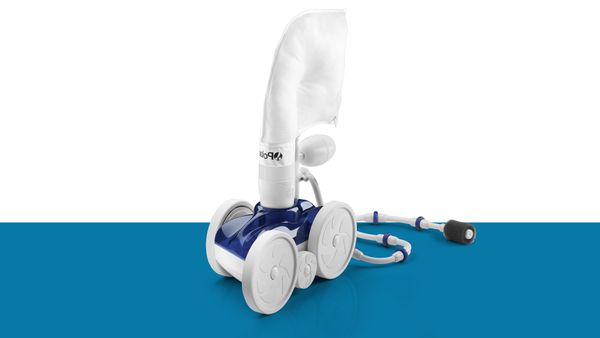
The Polaris Vac-Sweep 280 is a tried-and-true choice for small to medium-sized in-ground pools. Its 31-foot hose provides sufficient reach for pools of this size, but it may not cover larger or more complex pool layouts. Known for its reliability and durability, the Vac-Sweep 280 has maintained its popularity for decades due to its solid construction and straightforward operation. This cleaner excels at circulating water, an essential factor for maintaining a healthy swimming environment. However, the requirement for a booster pump adds to the cost and energy usage, which may be a consideration for some pool owners.
Pool Type: Small to medium in-ground pools
Best For: Moderate debris levels, standard-shaped pools
Why Choose: Time-tested reliability, effective water circulation, minimal tangling
Considerations: Requires a booster pump, limited hose length
Our Experience Using the Polaris Vac-Sweep 280: We've found the Vac-Sweep 280 to be incredibly reliable in day-to-day use. It’s a workhorse that doesn’t need constant attention. However, it's best suited for standard-shaped pools due to its hose length. The booster pump does add extra energy costs, but the cleaner makes up for it with its effective cleaning pattern and durability over time. We also noticed that while it moves around without tangling, its aimless navigation can leave some spots untouched.
Read my Polaris Vac-Sweep 280 Review →

If you have a large pool or one that often collects heavy debris like leaves, twigs, and dirt, the Polaris Quattro P40 is a top choice. This cleaner’s advanced features—such as four-wheel drive, dual scrubbing brushes, and a dual-stage filtration system—provide powerful and thorough cleaning. The Quattro P40 is particularly suited for pools with complex shapes or multiple levels, as it can navigate around obstacles and clean all surfaces, including walls and the waterline, with minimal manual intervention.
Pool Type: Large in-ground pools, pools with complex shapes or heavy debris loads
Best For: Comprehensive cleaning, handling all types of debris
Why Choose: High suction power, superior filtration, effective for pools with varying needs
Considerations: Higher price point, requires a booster pump
Our Experience Using the Polaris Quattro P40: The Quattro P40 quickly became a favorite for its versatility and power. During testing, it handled a variety of debris types exceptionally well, and we loved its ability to climb walls and clean the waterline. The dual filtration system is a game-changer, allowing it to capture both large and fine debris effectively. However, its need for a booster pump means higher upfront and operational costs, so it's best suited for those who prioritize performance over budget.
Read my Polaris Quattro P40 Review →
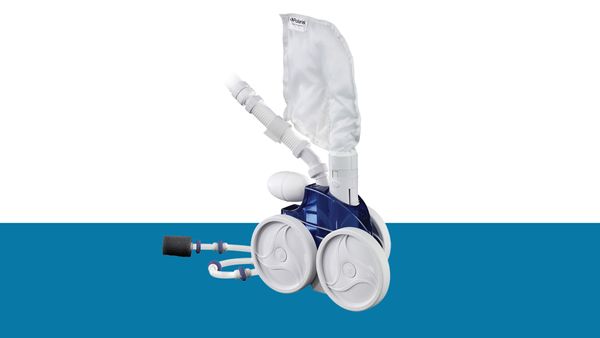
For pool owners who want to avoid the complexity and cost of installing a booster pump, the Polaris 360 stands out. It connects directly to the pool's existing filtration system, which simplifies installation and reduces energy consumption. The Polaris 360 is versatile, working well with single-speed, dual-speed, and variable-speed pumps. However, it may not provide the same level of suction power as cleaners that use a dedicated booster pump, which could impact its effectiveness in pools with heavy debris.
Pool Type: In-ground pools without a booster pump
Best For: Easy installation, cost efficiency, moderate debris levels
Why Choose: No booster pump required, versatile with different pump types, straightforward to maintain
Considerations: May struggle with larger debris or in pools that require high water pressure
Our Experience Using the Polaris 360: The Polaris 360 was a breeze to set up and perfect for those looking to skip the booster pump. We appreciated its versatility across different pump types, and it performed well in pools with moderate debris levels. However, we noticed a slight drop in cleaning power compared to booster-pump models, especially when dealing with heavy debris. It's a great option for those who prioritize energy efficiency and simplicity.
Read my Polaris Vac-Sweep 360 Review →
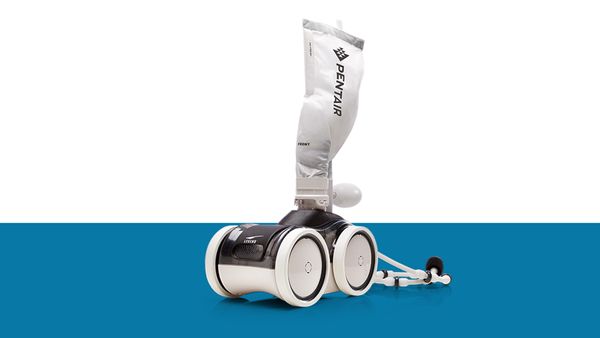
The Pentair LL505G Kreepy Krawly Legend is our top pick among Pentair pressure-side pool cleaners. This model is robust, durable, and well-suited for in-ground pools with moderate to heavy debris levels. With its four-wheel drive, large-capacity debris bag, and single-jet propulsion, the Legend offers dependable performance in pools of various shapes and sizes.
Pool Type: In-ground pools, especially those with moderate to heavy debris
Best For: Large debris, pools with tight corners
Why Choose: Effective debris handling, good maneuverability, reliable construction
Considerations: Requires a booster pump, lacks advanced features
Our Experience Using the Pentair LL505G Kreepy Krawly Legend: The Legend impressed us with its ability to handle large debris and navigate tight corners effectively. The four-wheel drive provides excellent traction, and the debris bag holds a substantial amount before needing to be emptied. However, its lack of advanced features means it doesn’t match the performance of newer robotic cleaners. It's a solid choice for those who want a straightforward, reliable cleaner without the need for constant attention.
Read my Pentair Kreepy Krawly Legend Review →

The Polaris Vac-Sweep 65 is ideal for above-ground vinyl pools. It connects to the pool's return line and operates without a booster pump, making it easy to install and maintain. Designed to handle surface debris like leaves and bugs, the Vac-Sweep 65 is best for pools that don't require deep or complex cleaning.
Pool Type: Above-ground vinyl pools
Best For: Light debris, surface cleaning
Why Choose: Easy installation, no booster pump needed, efficient for surface debris
Considerations: Limited to surface cleaning, does not handle fine debris or deep cleaning
Our Experience Using the Polaris Vac-Sweep 65: This cleaner was easy to set up and perfect for maintaining the surface of an above-ground pool. It handles light debris effectively and keeps the water surface clean. However, it doesn’t do well with debris that sinks to the bottom or requires deeper cleaning. It’s great for above-ground pool owners looking for a simple and affordable cleaning solution.
Read my Polaris Vac-Sweep 65 Review →
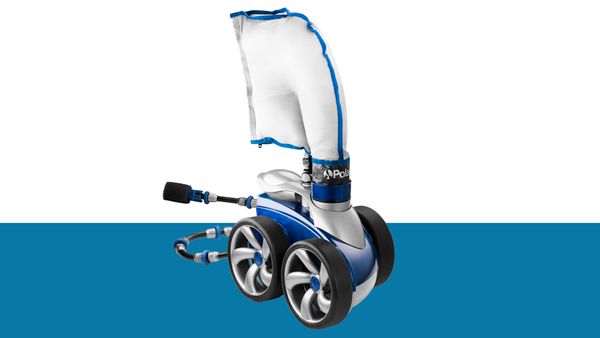
The Polaris Vac-Sweep 3900 Sport is worth considering for those who need a powerful pressure-side cleaner with enhanced debris capacity. It features triple-jet propulsion and a dual-chamber SuperBag, which holds more debris than standard models. This cleaner is suitable for larger in-ground pools but comes with higher energy consumption and frequent maintenance needs.
Pool Type: Large in-ground pools
Best For: Pools with high debris loads, fast cleaning
Why Choose: Strong suction, large debris bag capacity, excellent maneuverability
Considerations: High energy use, requires a booster pump, frequent maintenance
Our Experience Using the Polaris Vac-Sweep 3900 Sport: The Polaris 3900 Sport was impressive in its ability to handle heavy debris loads quickly, thanks to its powerful triple-jet propulsion. We appreciated the larger debris bag, which meant fewer stops to empty it. However, it consumed a lot of energy, and we found ourselves needing to perform frequent maintenance to keep it running smoothly. It's a great choice for those who need power and capacity, but it requires a bit more hands-on care.
Tip: Keep an eye on the belts and drive system, as these parts can wear out quickly with heavy use. Regular maintenance will help prolong its lifespan. You can buy a replacement drive belt here and keep it on hand if needed:
Read our full review on the Polaris Vac-Sweep 3900 Sport →
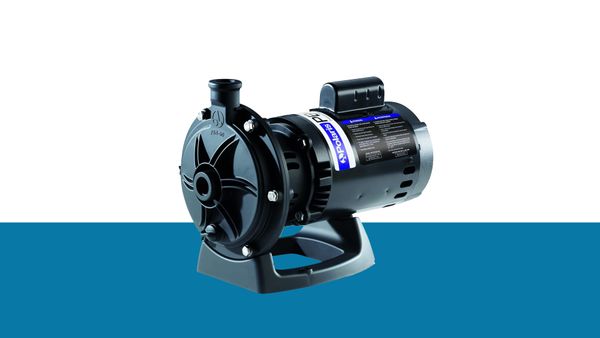
If you need a booster pump to power your pressure-side pool cleaner, the Polaris PB4-60 is the best choice. It is designed to deliver consistent pressure for optimal cleaning performance while maintaining energy efficiency compared to other pumps.
Pool Type: Pools using pressure-side cleaners
Best For: Maximizing pressure-side cleaner performance
Why Choose: Reliable performance, energy-efficient design
Considerations: Additional upfront cost and installation complexity
Our Experience Using the Polaris PB4-60 Booster Pump: This pump provided reliable and steady pressure, which helped our pressure-side cleaners perform at their best. We found that it was quieter and more energy-efficient than other models we’ve tried. However, it does come with an additional cost and installation effort. It's ideal if you’re committed to using pressure-side cleaners.
Read our full review on the Polaris PB4-60 →
Selecting the best pressure-side pool cleaner comes down to understanding your pool's specific needs:
Pool Size and Shape: For smaller, simpler pool designs, cleaners like the Polaris Vac-Sweep 280 or Polaris 360 might suffice. Larger or more complex pools may benefit from the advanced features and maneuverability of the Polaris Quattro P40.
Debris Type and Load: Consider the amount and type of debris your pool typically collects. The Polaris Quattro P40 and Vac-Sweep 3900 Sport are great for heavy debris, while the Vac-Sweep 65 works well for light, surface-level debris.
Booster Pump Requirements: If you prefer a cleaner that doesn’t require a booster pump, the Polaris 360 is an excellent option. However, if your pool setup already includes a booster pump, models like the Polaris Vac-Sweep 280 or Quattro P40 might offer better performance.
Budget and Maintenance Preferences: Higher-end models like the Polaris Quattro P40 provide more comprehensive cleaning but at a higher cost and with more maintenance. Simpler models like the Vac-Sweep 280 offer reliability and lower costs but may lack advanced features.
Having tested these cleaners in various pool environments, we found that each has its unique strengths. The Polaris Vac-Sweep 280, for example, is straightforward to use, requiring minimal setup and little hands-on intervention once installed. However, its lack of advanced navigation meant it often missed spots, and the need for a booster pump added to the complexity.
The Polaris Quattro P40, while more expensive, was impressive in its cleaning capabilities. It navigated complex pool layouts effortlessly, picked up all kinds of debris, and required less frequent maintenance. However, its reliance on a booster pump meant higher energy costs.
The Polaris 360 was the easiest to install, with no booster pump needed, making it a great choice for those looking to avoid the hassle and cost of additional equipment. However, its performance varied depending on the pool's plumbing setup.
Overall, choosing the best pressure-side pool cleaner depends on your specific pool needs, budget, and preferences. Each cleaner has its advantages, but understanding the trade-offs will help you make the most informed decision for your pool's health and your peace of mind.
A suction-side pool cleaner can make pool ownership significantly easier. We absolutely loved ours when we used the Polaris 280. But, times change and pressure-side pool cleaners are on the way out.
Their dated design and cost to run make a pressure-side pool cleaner irrelevant compared to a modern robotic pool cleaner. If you haven’t already, make sure to read our write up on robotic pool cleaners vs pressure-side pool cleaners.
Every model undergoes research, testing, and more in our test pools to bring you real results from pool experts. After years of experience in the pool industry, we are proud to bring you the best pressure-side pool cleaners we’ve ever used.
Pressure-side pool cleaners connect to the return line of your pool's circulation system and use water pressure from the pump to propel themselves around the pool. The cleaner is powered by a dedicated booster pump or the main filtration pump, depending on the model. As the cleaner moves, it uses water jets to create suction, which helps it pick up debris and direct it into an attached debris bag. The constant water flow also helps to agitate and circulate water, improving overall pool filtration.
The main difference between pressure-side and suction-side pool cleaners lies in how they are powered and where they connect within the pool's circulation system:
Pressure-Side Cleaners: These cleaners attach to the return side (pressure side) of the pool’s filtration system and are powered by water pressure created by either the main pool pump or a dedicated booster pump. They move around the pool and collect debris in an attached bag, which keeps the debris out of the pool’s filter. Pressure-side cleaners are generally more powerful and better at handling larger debris.
Suction-Side Cleaners: These cleaners connect to the suction side of the pool’s filtration system, usually via a skimmer or a dedicated suction line. They use the suction created by the pool pump to move around the pool and vacuum debris directly into the pool’s filtration system. Suction-side cleaners are typically less expensive and easier to install, but they rely on the pool’s main filter to handle debris, which can lead to more frequent filter cleaning.
It depends on your pool’s needs and your priorities. Pressure-side pool cleaners are generally less expensive upfront than robotic cleaners and are very effective at handling large debris loads. However, they require a booster pump, which can increase energy costs and installation complexity. Pressure-side cleaners also lack the advanced navigation features of robotic cleaners, which can result in less efficient cleaning.
Robotic pool cleaners, on the other hand, are often considered the superior choice due to their advanced technology, energy efficiency, and ease of use. They operate independently of the pool’s filtration system, require no booster pump, and use smart navigation to cover every inch of the pool. While robotic cleaners have a higher upfront cost, they tend to be more energy-efficient and require less maintenance over time.
Yes, most pressure-side pool cleaners are safe for vinyl pools. They are designed to operate on various pool surfaces, including vinyl, fiberglass, and concrete. However, it’s essential to ensure that the cleaner’s wheels and brushes are vinyl-friendly and do not have any abrasive parts that could potentially damage the liner. Always check the manufacturer’s recommendations and choose a cleaner that is explicitly stated as safe for use on vinyl surfaces.
While most pressure-side pool cleaners are designed for in-ground pools, some models, like the Polaris Vac-Sweep 65, are specifically designed for above-ground pools. These models do not require a booster pump and connect directly to the pool’s return line. However, not all pressure-side cleaners are suitable for above-ground pools, so it's essential to check the product specifications before purchasing.
To install a pressure-side pool cleaner, follow these general steps:
Attach the Hose: Connect the cleaner’s hose to the return line or the dedicated pressure line of your pool. Ensure all hose connections are tight and secure to prevent leaks.
Install the Booster Pump (if required): If your cleaner requires a booster pump, install it according to the manufacturer’s instructions. This usually involves mounting the pump near the pool equipment pad and connecting it to the main filtration system.
Calibrate the Cleaner: Adjust the cleaner’s float positions and hose length to ensure it can reach all areas of the pool. Make sure the hose is not too short or too long to prevent tangling.
Test the Cleaner: Turn on the booster pump (or the pool pump if no booster is required) and check that the cleaner is moving correctly and efficiently around the pool. Make any necessary adjustments to optimize performance.
Monitor and Maintain: Regularly check the cleaner, hoses, and debris bag for wear and tear. Clean the debris bag frequently and ensure the cleaner operates at peak performance.
Always refer to the specific manual provided by the manufacturer for detailed instructions, as installation steps can vary by model.